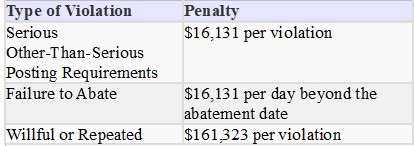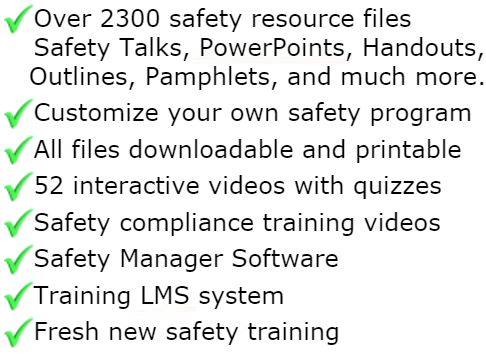
Safety Program - Dry Ice (Solid Carbon Dioxide)
Purpose
This policy establishes procedures for the safe storage, usage, and handling of dry ice in [COMPANY] facilities.
The significant hazards of dry ice include burns and asphyxiation. Insulated gloves must be worn when handling dry ice. Use of dry ice in poorly ventilated areas can result in depletion of the oxygen level resulting in asphyxiation.
AFFECTED DEPARTMENTS & EMPLOYEE JOB TITLES
[LIST DEPARTMENTS]
[LIST JOB TITLES]
DEFINITIONS & USES
Dry ice is the solid form of carbon dioxide, non-combustible, available in flakes, pellets or block form. Dry ice will sublime (vaporizes directly to the gas state) at a temperature of –78.5C (-109.3 F) or higher.
Dry ice is used in company facilities in the following forms for the following purposes:
[LIST EACH FORM & USE]
Employees
All company employees must follow the safe storage, usage, and handling of dry ice.
Safety Department
Upon discovery of improper storage or handling of dry ice, Safety Department will notify the appropriate Department Head.
Safety department will create an effective employee training program for all employees who work with or around operations using dry ice.
Safety department will create emergency response plan for situations involving excess buildup of carbon monoxide.
Department Heads
Department Heads will provide appropriate training for any employee who works with or around dry ice. Employees responsible for shipping packages containing dry ice, must be properly trained in United States Department of Transportation (USDOT) shipping requirements and authorized by the company to pack and ship packages containing dry ice.
Department Heads will ensure proper atmospheric testing is periodically conducted to ensure carbon dioxide levels remain below permissible exposure levels.
Department heads will cause periodic inspections to be conducted to ensure all production, use and storage requirements are met.
PROCEDURES
A. Storage:
1. Dry ice is to be stored in a well-ventilated locations and placed in insulated and ventilated storage areas, chesta, insulated coolers, or a special coolers designed for the storage of dry ice.
2. Because of the thermal expansion of dry ice (one pound of dry ice produces abut 250 liters of gaseous carbon dioxide), sufficient gaseous carbon dioxide can be released in a sealed container to cause an pressure explosion. Dry ice is NEVER to be stored in any type of tightly sealed devices such as an ultra-low freezer or plastic/glass container.
3. Dry ice will sublimate about five to ten pounds every 24 hours (blocks last longer) in a typical storage cooler.
4. Normal air is composed of 78% nitrogen, 21% oxygen, and only 0.04% carbon dioxide. Concentrations greater than 0.5% (5000 ppm) can become dangerous. Storage and operation locations must be periodically surveyed to ensure carbon dioxide levels remain below 5000 ppm .
B. Hazards/Precautions:
1. Burns/frostbite: Dry ice can cause burns to the skin in short periods of times. Thermal rated gloves are to be used to handle dry ice.
2. Suffocation: carbon dioxide is a simple asphyxiant. Always store dry ice in a well-ventilated area to minimize the build up of carbon dioxide. Personnel must use caution should dry ice be stored in a deep cooler. Personnel must be trained to never stick their head into the chest to obtain dry ice.
3. Explosions: Placing dry ice into a tightly sealed container can permit sufficient gas build up to cause an explosion. Never place dry ice inside an ultra-low freezer or other enclosed space!
4. Placement of dry ice in rooms with little or no ventilation can result in a build-up of the carbon dioxide in the area. Do not store dry ice in a confined area such as in walk-in coolers, refrigerators, freezers, closets, or cars/vans.
5. The Material Safety data Sheet for dry ice is available at _ _ _ _ _ _ _ _ _ _ _ _ _ .
6. Medical assistance for dry ice injuries is available by contacting _ _ _ _ _ _ _ _ _ _ _ _ _ . Report injuries from dry ice using the Incident Report Forms available at _ _ _ _ _ _ _ _ _ _ _ _ _ .
7. When using dry ice to ship materials, the shipper must follow all applicable shipping regulations.
8. Disposal of unneeded dry ice is accomplished by:
a.Letting the unused portion sublimate (recommended for well-ventilated locations because it will occur over a period of several days and the ventilation will take care of the gas liberated);
b. NEVER dispose of dry ice in a sink, toilet or other drain (such action can destroy the structure because of the temperature difference);
c. NEVER dispose of dry ice in the trash or garbage; and
d. NEVER place unneeded dry ice in corridors (some corridors may not be well ventilated and the oxygen level can be reduced to low levels).
C. Personal Protective Equipment
Respiratory Protection: SCBA in oxygen deficient atmospheres/where CO2 >1.5%. Don't use air purifying respirators.
Ventilation: Local Exhaust: At point sources of CO2 vapors. Mechanical (general): Low lying area are not naturally ventilated.
Protective Gloves: Impermeable/loose fitting (leather)
Eye Protection: Safety glasses
D. Operations
Production - Systems to produce Dry Ice from liquid carbon dioxide uses specifically designed tanks, valves, and collection equipment. System and equipment must be operated and inspected in accordance with the specific manufacturer's safety and operating instructions
Handling - Dry Ice temperature is extremely cold at -109.3°F or -78.5°C. Always handle Dry Ice with care and wear protective cloth or leather gloves whenever touching it. An oven mitt or towel will work. If touched briefly it is harmless, but prolonged contact with the skin will freeze cells and cause injury similar to a burn.
Storage - Store Dry Ice in an insulated container. The thicker the insulation, the slower it will sublimate. Do not store Dry Ice in a completely airtight container. The sublimation of Dry Ice to Carbon Dioxide gas will cause any airtight container to expand or possibly explode. Keep proper air ventilation wherever Dry Ice is stored. Do not store Dry Ice in unventilated rooms, cellars, autos or boat holds. The sublimated Carbon Dioxide gas will sink to low areas and replace oxygenated air. This could cause suffocation if breathed exclusively. Do not store Dry Ice in a refrigerator freezer. The extremely cold temperature will cause your thermostat to turn off the freezer. It will keep everything frozen in the freezer but it will be used up at a faster rate. It is the perfect thing if your refrigerator breaks down in an emergency.
Ventilation - Normal air is 78% Nitrogen, 21% Oxygen and only 0.035% Carbon Dioxide. If the concentration of carbon dioxide in the air rises above 0.5%, carbon dioxide can become dangerous. Smaller concentrations can cause quicker breathing but is otherwise not harmful. If Dry Ice has been

GET INSTANT ACCESS
to THE MEMBERS LIBRARY
Safety materials created by safety professionals.
Access to the Safety Manager software.
Wide variety of safety videos and courses.
**Brand New** Safety Training Management System
Pre-Made Safety Materials Ready For Use
Created by experienced safety professionals & risk consultants. Saving you time, money, and risk of injuries.
95% of the work already done.
Below are the maximum penalty amounts, with the annual adjustment for inflation, that may be assessed after Jan. 15, 2024. (See OSHA Memo, Jan. 8, 2024).

**New OSHA HEAT 90 DAY**
>>Download Free HERE<<
**New 2024 OSHA 300 Form**
>>Download Free HERE<<
**Brand New**
Free with full membership subscription
Training LMS System
Ask The Safety Consultant
Safety Equipment Deal Finder

“SafetyInfo.com is the first go-to website for safety professionals and companies to use in establishing a solid safety program"
-Mike McKenzie, Certified Safety & Health Manager (CSHM), McSafety Solutions™
Note: You must have a full subscription to the Safety Library in order to use this material. Any use outside of your organization, for resell, or without an active membership is strictly prohibited and may result in prosecution under copyright infringement laws. Please contact us first, if you would be interested in reselling or using our materials for reproduction.
Inside the Members Library
Topic Index
Accident Prevention
Air Quality
Asbestos
Bloodborne Pathogens
Boilers
Chemical Safety
Compressed Gas
Confined Space
Construction
Construction Worksite
Cranes & Slings
Driver / Fleet Safety
Drug Free Workplace
Electrical
Emergency Management
Engineering Safety
Environmental
Equipment
Ergonomics
Fall Protection
Fire Safety & Prevention
First Aid
Flammable Materials
Forklifts
Hazard Communication
Hazardous Materials
Hearing Protection
Heat Stress
Hot Work
Housekeeping
Job Safety Analysis
Laboratory
Ladders
Lead
Lockout-Tagout
Machinery & Equipment
Material Handling
MSDS (SDS)
Medical & First Aid
Occupational Health
Office Safety
Off the Job Safety
Personal Protection
Process Safety
Record Keeping
Respiratory Protection
Silica Safety
Rules & Policies
Signs & Labels
Slips, Trips & Fall
Training
Terrorism Programs
Tool Safety
Vehicle & Driver
Violence Programs
Welding & Hot Work
Training Videos
Library Index
Training Materials
Videos/Courses
Talks
Articles
PowerPoint
Handouts
Training Overheads
Quizzes
Supervisor Briefs
Management Briefs
Safety Sessions
2 Minute OSHA Safety Talks
Pamphlets
First Aid Training
Supervisor Training
Hazardous Materials
Bomb Threat
Crossword Puzzles
Biological Agents
Forms & Documents
Forms
Checklists
Audit Guides
Inspections Guides
Signs & Labels
Environmental Audit Guides
Recordkeeping - OSHA 300
Sign & Label Maker
Safety Management Resources
Safety Manuals/Written Programs
Ergonomic Programs
Emergency Plans
Process Safety Management
Construction Safety
Occupational Health
Environmental
Topic Sheets
DOT Fleet-Driver
Hazardous Materials
Chemical Safety
Drug Free Workplace
Terrorism Programs
Development Guides
Safety Manager Software
Safety References & Graphics
Technical Safety Information
Posters
Topic & Fact Sheets
Development Information
Job Specific Safety Rules
Terrorism
Calculators
Safety Comic Strips
New Safety Training System
Schedule and train your employees with our materials. Add unlimited amount of employees. Record all progress and issue certificates. For group and individual training sessions.

